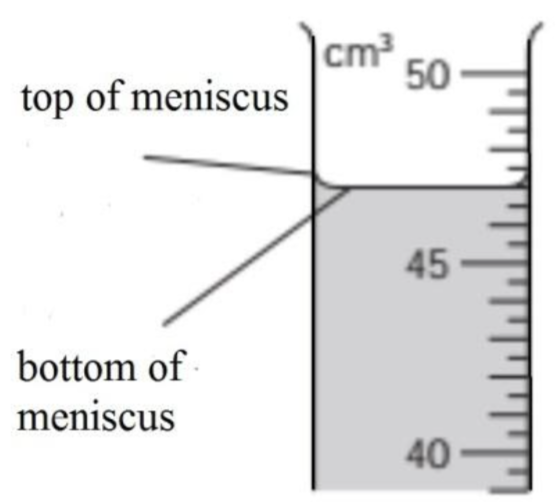
A student uses a measuring cylinder to measure the volume of some water. The diagram shows part of the measuring cylinder. The top and bottom of the meniscus are labeled. What is the volume of the water?


Answer
494.7k+ views
1 likes
Hint: The trick to solve this type of answer is to observe the given diagram carefully, as the answer is hidden in the diagram itself. If the liquid forms a concave meniscus, then the corresponding bottom of the meniscus should be noted as an answer and vice versa.
Complete step-by-step solution:
From given, we have the data,
The top reading of the meniscus = 47.5 cubic cm
The bottom reading of the meniscus = 47 cubic cm
The liquid in the measuring cylinder is water.
The meniscus reading depends on the liquid present in the measuring cylinder.
There are two types of meniscus. They are concave meniscus and convex meniscus. The liquids whose molecules are strongly attracted to the walls of the container then each other have a concave meniscus. Similarly, the liquids whose molecules are weakly attracted to the walls of the container than each other have a convex meniscus.
The given diagram represents the measuring cylinder filled with water, and water has a concave meniscus, the reading to be considered is the bottom of the meniscus.
As the volume of the water represented by the measuring cylinder is equal to 47 cubic centimeters, thus, option (A) is correct.
Additional information:
If the liquid is water, the bottom reading of the meniscus is considered and if the liquid is mercury, the top reading of the meniscus is considered.
Note: The things to be on your finger-tips for further information on solving these types of problems are: If in case the meniscus of two liquids is given in terms of molecular attraction, then the liquid with the strongest molecular attraction will have concave meniscus and vice versa.
Complete step-by-step solution:
From given, we have the data,
The top reading of the meniscus = 47.5 cubic cm
The bottom reading of the meniscus = 47 cubic cm
The liquid in the measuring cylinder is water.
The meniscus reading depends on the liquid present in the measuring cylinder.
There are two types of meniscus. They are concave meniscus and convex meniscus. The liquids whose molecules are strongly attracted to the walls of the container then each other have a concave meniscus. Similarly, the liquids whose molecules are weakly attracted to the walls of the container than each other have a convex meniscus.
The given diagram represents the measuring cylinder filled with water, and water has a concave meniscus, the reading to be considered is the bottom of the meniscus.
As the volume of the water represented by the measuring cylinder is equal to 47 cubic centimeters, thus, option (A) is correct.
Additional information:
If the liquid is water, the bottom reading of the meniscus is considered and if the liquid is mercury, the top reading of the meniscus is considered.
Note: The things to be on your finger-tips for further information on solving these types of problems are: If in case the meniscus of two liquids is given in terms of molecular attraction, then the liquid with the strongest molecular attraction will have concave meniscus and vice versa.
Recently Updated Pages
Master Class 11 Business Studies: Engaging Questions & Answers for Success

Master Class 11 Accountancy: Engaging Questions & Answers for Success

Master Class 11 Computer Science: Engaging Questions & Answers for Success

Master Class 11 English: Engaging Questions & Answers for Success

Master Class 11 Social Science: Engaging Questions & Answers for Success

Master Class 11 Economics: Engaging Questions & Answers for Success

Trending doubts
Which one is a true fish A Jellyfish B Starfish C Dogfish class 11 biology CBSE

State and prove Bernoullis theorem class 11 physics CBSE

1 ton equals to A 100 kg B 1000 kg C 10 kg D 10000 class 11 physics CBSE

In which part of the body the blood is purified oxygenation class 11 biology CBSE

One Metric ton is equal to kg A 10000 B 1000 C 100 class 11 physics CBSE

Difference Between Prokaryotic Cells and Eukaryotic Cells




